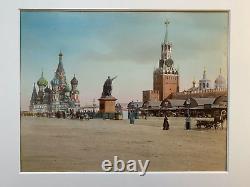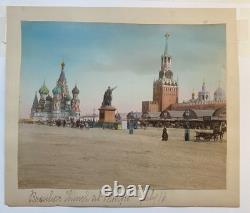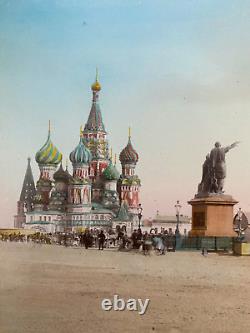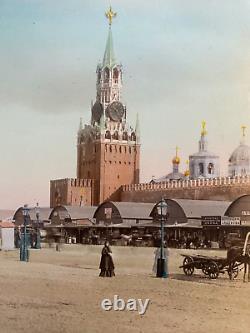Imperial Russian Hand Coloured Antique Albumen Photo Moscow Red Square St Basils










Bibelotslondon Ltd is a UK registered company based in London Bridge dealing in ephemera and curiosities from Britain and around the world. Our diverse inventory is carefully chosen and constantly evolving. We work very hard to offer the highest quality works at competitive prices. Our inventory is listed online, and we strive to keep our website completely up to date, so our customers can easily check availability. We believe in offering clients items that are unique and rare for aficionados of the antique and collector's world.
Bibelot is a late nineteenth century word derived from the French word bel'beautiful', meaning a small item of beauty, curiosity or interest. The word ephemera is derived from the sixteenth century Greek word ephmera meaning a printed or hand written paper not meant to be retained for a long period of time. Hand coloured antique photograph circa 1880 of Red Square in Moscow, Russia. Red Square separates the Kremlin, the former royal citadel and currently the official residence of the President of Russia, from a historic merchant quarter known as Kitai-gorod. Red Square is often considered the central square of Moscow since Moscow's major streets, which connect to Russia's major highways, originate from the square.
The name Red Square neither originates from the pigment of the surrounding bricks (which, in fact, were whitewashed at certain periods) nor from the link between the color red and communism. Rather, the name came about because the Russian word???????
(krasnaya), which means "red, " was applied to a small area between St. Basil's Cathedral, the Spassky Tower of the Kremlin, and the Lobnoe Mesto (it actually never was a place of execution), and Tsar Alexei Mikhailovich officially extended the name to the entire square, which had previously been called Pozhar, or "burnt-out place", in reference to the fact that several buildings had to be burned down to make place for the square. In 1804, at the request of merchants, the square was paved in stone. In 1806 Nikolskaya Tower was reconstructed in the Gothic style, and received a tent roof. The new phase of improvement of the square began after the Napoleonic invasion and fire in 1812. The moat was filled in 1813 and in its place, rows of trees were planted. The market Line along the moat, dilapidated after the fire, had been demolished, and on the Eastern side, Joseph Bové constructed new building of lines in the Empire style. In 1818 the Monument to Minin and Pozharsky, which can be seen in the photo, was erected, symbolising the rise in patriotic consciousness during the war.In 1874 the historic building of Zemsky prikaz was demolished. In its place the Imperial Historical Museum was built in pseudo-Russian style. After Bové's lines were demolished, new large buildings were erected between 1888 and 1893, also in the pseudo-Russian style: upper lines (Gum department store) and middle lines.
The upper lines were intended for retail sale and together in fact comprised the first department store in Moscow. During the Soviet era, Red Square maintained its significance, becoming a focal point for the new state. Besides being the official address of the Soviet government, it was renowned as a showcase for military parades from 1919 onward.
Lenin's Mausoleum would from 1924 onward be a part of the square complex, and also as the grandstand for important dignitaries in all national celebrations. In the 1930s, Kazan Cathedral and Iverskaya Chapel with the Resurrection Gates were demolished to make room for heavy military vehicles driving through the square (both were later rebuilt after the fall of the Soviet Union).
There were plans to demolish Moscow's most recognized building, Saint Basil's Cathedral, as well to make way for a larger Red Square, as well as the State Historical Museum. The legend is that Lazar Kaganovich, Stalin's associate and director of the Moscow reconstruction plan, prepared a special model of Red Square, in which the cathedral could be removed, and brought it to Stalin to show how the cathedral was an obstacle for parades and traffic. But when he jerked the cathedral out of the model, Stalin objected with his rather famous quote: Lazar! On the Eastern side of the square is the GUM department store, and next to it the restored Kazan Cathedral. The Northern side is occupied by the State Historical Museum, whose outlines echo those of Kremlin towers. The Iberian Gate and Chapel have been rebuilt to the Northwest. The only sculptured monument on the square is a bronze statue of Kuzma Minin and Dmitry Pozharsky, who helped to clear Moscow from the Polish invaders in 1612, during the Times of Trouble. Housed in a modern wooden frame mounted under conservation glass by Pure & Applied restorers of London. Size: 33 x 38 cm approx. Photos form part of the description.
